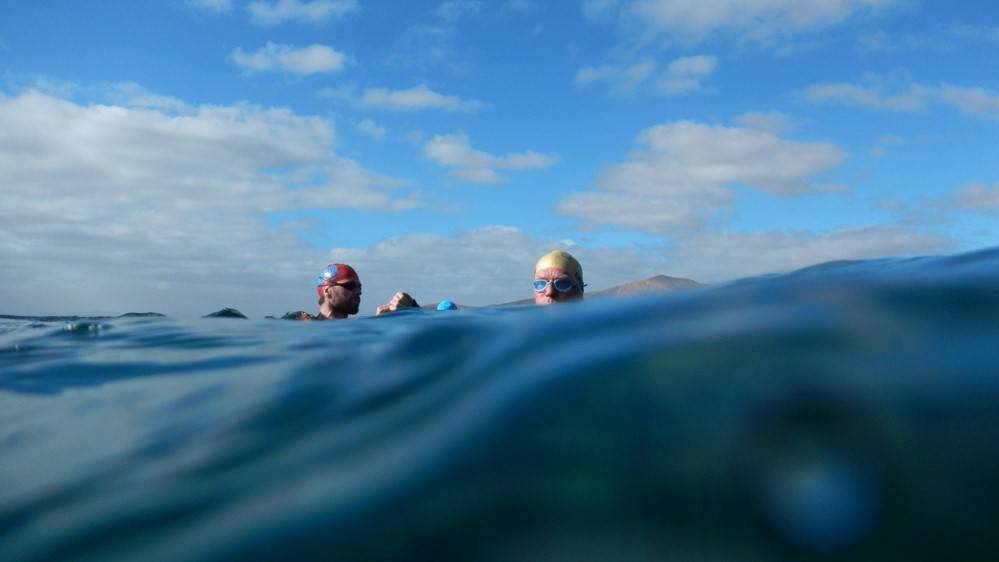Das Schwimmen in einem natürlichen Gewässer unterscheidet sich deutlich vom Schwimmen im Hallen- oder Freibad. Statt ordentlich einer Bahn zu folgen, muss man selbst den Kurs setzen und ihn auch halten. Im grünlich braunen Wasser sieht man höchstens eine Armlänge weit und was unter einem lauert, möchte man eigentlich gar nicht so genau wissen. Wir meinen dennoch: keine Angst vor Ungeheuern!
Beachtet man die folgenden Regeln, steht einem Training im natürlichen Gewässer nichts mehr im Weg:
Für Sicherheit sorgen
Nie allein im Freiwasser trainieren. Wenn man keinen Mitschwimmer hat, sollte man wenigstens eine Person dabei haben, die einen vom Ufer aus beobachtet. Notfalls kann diese Hilfe leisten oder verständigen. Um gut sichtbar zu sein, sollte eine Badekappe in leuchtender Farbe getragen werden.
Ruhig und locker bleiben
Vieles was einem im Wasser Angst macht ist irrational. Oft hilft es schon sich das Gewässer in dem man Schwimmen möchte genauer anzuschauen und sich damit vertraut zu machen. Dabei reicht es in Ufernähe im flachen Wasser zu plantschen oder sich einfach etwas treiben zu lassen. Der Neo gibt dabei Auftrieb, hält den Körper an der Oberfläche und lässt einen nicht untergehen. Wichtig ist es ruhig und locker zu bleiben. Ein Trainingspartner gibt bei der gemeinsamen Erkundung zusätzliche Sicherheit.
Wer ohne Neo schwimmt oder sich zusätzlich absichern möchte, kann sich zum Beispiel mit einem „restube“ ausstatten. Diese kleine zusammenfaltbare Rettungsboje wird in einer Tasche am Körper getragen und lässt sich im Notfall durch eine CO2 Patrone schnell aufblasen. Mit der Schwimmhilfe kann man sich dann über Wasser halten bis Hilfe eintrifft.
Unterkühlung vermeiden
Ist das Wasser kalt gilt es sich erstmal auf Betriebstemperatur zu bringen. Ein Aufwärmprogramm am Ufer schützt vor schnellem Auskühlen. Ins Wasser sollte man langsam gehen um den Körper an die Kälte zu gewöhnen. Ist der Neo zunächst leicht geöffnet, kann Wasser eindringen, das durch die Körpertemperatur gewärmt wird. Dadurch bildet sich die wichtige Isolationsschicht zwischen Körper und Neo schneller. Bei einer Wassertemperatur unter 15°C sollten zusätzlich Handschuhe, Socken und Haube getragen werden. Die Zeit im Wasser so gering wie möglich halten. Ist es nicht ganz so kalt reichen meist zwei Badekappen übereinander. Bis an die Schwimmbrille gezogen bieten sie der Stirn Schutz. Denn kühlt diese aus, kann man schnell Kopfschmerzen bekommen. Auch die Ohren müssen möglichst vor dem Eindringen von Wasser geschützt werden. Wichtig ist es auf die Anzeichen einer Unterkühlung zu achten. Bei Zittern, Kältegefühl, Müdigkeit und Schwindel, im schlimmeren Fall auch Desorientierung und Kreislaufversagen, sollte man sofort aus dem Wasser und sich aufwärmen.
Orientierungspunkte nutzen
Markante Punkte am Ufer lassen sich zur Orientierung anpeilen. Um diese und andere Schwimmer im Wasser nicht aus den Augen zu verlieren, sollte man alle fünf bis sechs Züge hochschauen. Helfen kann dabei der Wasserballkraulzug bei dem den Kopf aus dem Wasser heben und nach vorne schauen kann. Mit speziellen Übungen lassen sich Geradeausschwimmen und Orientierungssinn verbessern. Zusätzlich sollte das beidseitige Atmen geübt werden. Dadurch kann man sich zu beiden Seiten an der Uferlinie orientieren.
Für Durchblick sorgen
Es empfiehlt sich eine Schwimmbrille mit getönten Gläsern zu tragen. Reflexionen und Spiegelungen im Wasser werden durch die Tönung reduziert und die Sicht nicht so stark beeinträchtigt. Außerdem werden die Augen vor grellem Licht und UV Strahlen geschützt.
Und wer weiß, vielleicht ist das Seeungeheuer das man im Wasser vermutet ja in Wirklichkeit nur eine Meerjungfrau, die sich auf den nächsten Wettkampf vorbereitet.




















